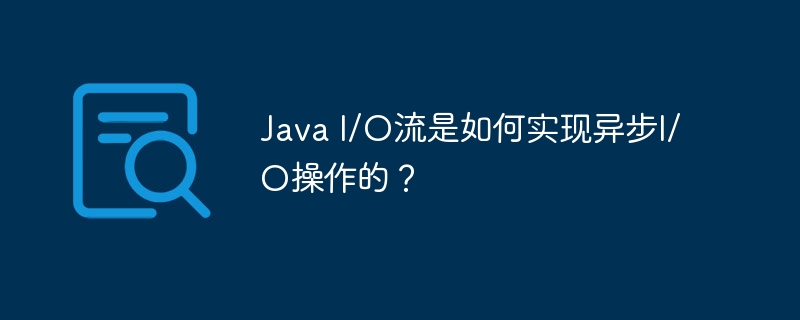How does Java I/O stream implement asynchronous I/O operations?
Java I/O streams implement asynchronous I/O operations by using classes provided by the java.nio package, including AsynchronousChannel and CompletionHandler. These classes provide methods for initiating asynchronous read (readAsync) and write (writeAsync) operations. This mechanism improves I/O performance by allowing applications to continue executing without waiting for I/O operations to complete.

How Java I/O streams implement asynchronous I/O operations
Introduction
In Java, Asynchronous I/O operations allow an application to continue executing while waiting for an I/O operation (such as reading or writing a file) to complete. This article explores how Java I/O streams implement asynchronous I/O operations.
Java NIO
Asynchronous I/O is implemented in Java through the java.nio package. This package provides the following classes for asynchronous I/O:
-
AsynchronousChannel: Represents a channel that supports asynchronous I/O operations. -
CompletionHandler: Callback interface for handling completed asynchronous I/O operations.
Asynchronous I/O stream
The Java I/O stream class provides methods to interact with AsynchronousChannel to support asynchronous I/O /O operations. These methods include:
-
readAsync: Initiates an asynchronous read operation. -
writeAsync: Initiate an asynchronous write operation.
Practical case
The following is an asynchronous I/O operation using the readAsync and writeAsync methods Example:
import java.io.FileInputStream;
import java.io.FileOutputStream;
import java.nio.ByteBuffer;
import java.nio.channels.AsynchronousFileChannel;
import java.nio.channels.CompletionHandler;
public class AsyncIOExample {
public static void main(String[] args) throws Exception {
// 创建 AsynchronousFileChannel
AsynchronousFileChannel inChannel = AsynchronousFileChannel.open(new FileInputStream("input.txt"));
AsynchronousFileChannel outChannel = AsynchronousFileChannel.open(new FileOutputStream("output.txt"));
// 创建缓冲区
ByteBuffer buffer = ByteBuffer.allocate(1024);
// 发起异步读取操作
inChannel.read(buffer, 0, null, new CompletionHandler<Integer, Void>() {
@Override
public void completed(Integer result, Void attachment) {
// 读取数据成功
// ...
// 发起异步写入操作
outChannel.write(buffer, 0, null, new CompletionHandler<Integer, Void>() {
@Override
public void completed(Integer result, Void attachment) {
// 写入数据成功
// ...
}
@Override
public void failed(Throwable exc, Void attachment) {
// 写入数据失败
// ...
}
});
}
@Override
public void failed(Throwable exc, Void attachment) {
// 读取数据失败
// ...
}
});
}
}Conclusion
By using the java.nio package, Java I/O streams can implement asynchronous I/O operations. This enables applications to improve I/O performance, thereby improving overall performance.
The above is the detailed content of How does Java I/O stream implement asynchronous I/O operations?. For more information, please follow other related articles on the PHP Chinese website!

Hot AI Tools

Undresser.AI Undress
AI-powered app for creating realistic nude photos

AI Clothes Remover
Online AI tool for removing clothes from photos.

Undress AI Tool
Undress images for free

Clothoff.io
AI clothes remover

AI Hentai Generator
Generate AI Hentai for free.

Hot Article

Hot Tools

Notepad++7.3.1
Easy-to-use and free code editor

SublimeText3 Chinese version
Chinese version, very easy to use

Zend Studio 13.0.1
Powerful PHP integrated development environment

Dreamweaver CS6
Visual web development tools

SublimeText3 Mac version
God-level code editing software (SublimeText3)

Hot Topics
 Square Root in Java
Aug 30, 2024 pm 04:26 PM
Square Root in Java
Aug 30, 2024 pm 04:26 PM
Guide to Square Root in Java. Here we discuss how Square Root works in Java with example and its code implementation respectively.
 Perfect Number in Java
Aug 30, 2024 pm 04:28 PM
Perfect Number in Java
Aug 30, 2024 pm 04:28 PM
Guide to Perfect Number in Java. Here we discuss the Definition, How to check Perfect number in Java?, examples with code implementation.
 Random Number Generator in Java
Aug 30, 2024 pm 04:27 PM
Random Number Generator in Java
Aug 30, 2024 pm 04:27 PM
Guide to Random Number Generator in Java. Here we discuss Functions in Java with examples and two different Generators with ther examples.
 Weka in Java
Aug 30, 2024 pm 04:28 PM
Weka in Java
Aug 30, 2024 pm 04:28 PM
Guide to Weka in Java. Here we discuss the Introduction, how to use weka java, the type of platform, and advantages with examples.
 Armstrong Number in Java
Aug 30, 2024 pm 04:26 PM
Armstrong Number in Java
Aug 30, 2024 pm 04:26 PM
Guide to the Armstrong Number in Java. Here we discuss an introduction to Armstrong's number in java along with some of the code.
 Smith Number in Java
Aug 30, 2024 pm 04:28 PM
Smith Number in Java
Aug 30, 2024 pm 04:28 PM
Guide to Smith Number in Java. Here we discuss the Definition, How to check smith number in Java? example with code implementation.
 Java Spring Interview Questions
Aug 30, 2024 pm 04:29 PM
Java Spring Interview Questions
Aug 30, 2024 pm 04:29 PM
In this article, we have kept the most asked Java Spring Interview Questions with their detailed answers. So that you can crack the interview.
 Break or return from Java 8 stream forEach?
Feb 07, 2025 pm 12:09 PM
Break or return from Java 8 stream forEach?
Feb 07, 2025 pm 12:09 PM
Java 8 introduces the Stream API, providing a powerful and expressive way to process data collections. However, a common question when using Stream is: How to break or return from a forEach operation? Traditional loops allow for early interruption or return, but Stream's forEach method does not directly support this method. This article will explain the reasons and explore alternative methods for implementing premature termination in Stream processing systems. Further reading: Java Stream API improvements Understand Stream forEach The forEach method is a terminal operation that performs one operation on each element in the Stream. Its design intention is






